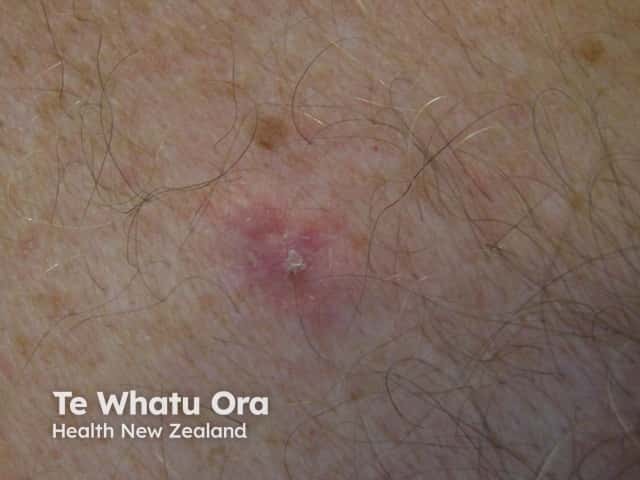Main menu
Common skin conditions

NEWS
Join DermNet PRO
Read more
Quick links
Author: Dr David Lim, Dermatology Registrar, Greenlane Hospital, Auckland, New Zealand, 2010.
Introduction
Demographics
Appearance
Treatment
Post-treatment
Primary cutaneous adenoid cystic carcinoma (PCACC) is a rare skin cancer thought to originate from sweat ducts.
PCACC is part of a group of tumours called adenoid cystic carcinomas. They share similar features under the microscope (see pathology of adenoid cystic carcinoma) but have distinct differences in clinical behaviour and prognosis. Types of adenoid cystic carcinoma include:
The cutaneous type (PCACC) progresses slowly and rarely spreads to other areas of the body. It has a better prognosis than others in the group such as the salivary gland type. The cause is unknown.
PCACC usually affects adults with fair complexion. It typically occurs between the ages of 50 and 70 years old. It occurs in men and women equally and more frequently with increasing age.
While immunosuppression increases the risk for some other cancers such as squamous cell carcinoma (SCC), this does not increase the risk of PCACC.
Due to the rarity of this cancer, other risk factors have not yet been identified.
PCACC is usually a firm skin-coloured solitary nodule or plaque. It grows slowly over months to years. It most commonly occurs on the scalp. Other sites include the head, face, neck, trunk and perineum.

Primary cutaneous adenoid cystic carcinoma

Primary cutaneous adenoid cystic carcinoma
Treatment for PCACC depends upon its size and location. Most lesions are surgically excised. A wide margin (e.g. 1 cm) is recommended to reduce the risk of recurrence, as it is often difficult to determine the border between the cancer and normal skin. Mohs micrographic surgery has been used in a few cases where it is difficult to achieve a wide margin around the tumour.
Radiotherapy is commonly used as adjunctive therapy, and may be recommended if margins are narrow or the lesion has been incompletely excised.
While most PCACCs are cured by initial treatment, a large proportion (reports range from 22 to 70%) recur at the original location. This is more likely if the histology has shown perineural invasion, incomplete removal or narrow margins. Recurrence usually occurs within 5 years, although there are reports of recurrence up to 35 years after initial removal.
Spread to other areas of the body (metastasis) is very rare. When it does occur, PCACC most commonly spreads to the lungs.
Metastatic PCACC is treated with a combination of surgical excision, radiotherapy and chemotherapy.